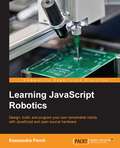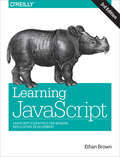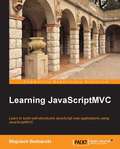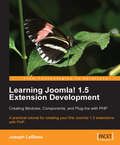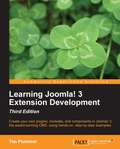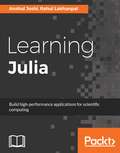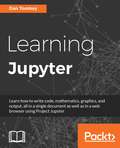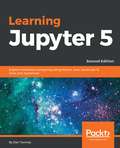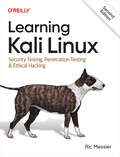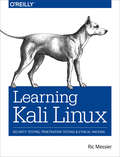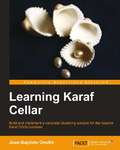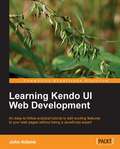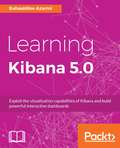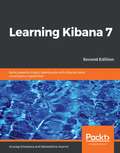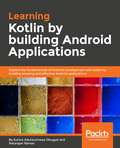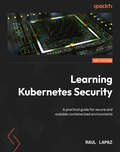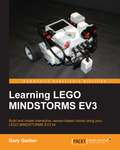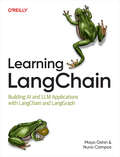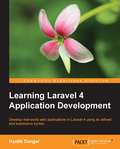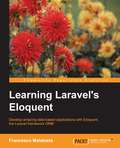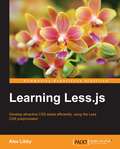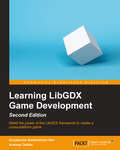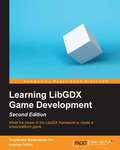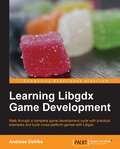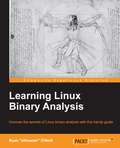- Table View
- List View
Learning JavaScript Robotics
by Kassandra PerchDesign, build, and program your own remarkable robots with JavaScript and open source hardware About This Book * Learn how to leverage Johnny-Five's Read, Eval, Print Loop, and Event API to write robot code with JavaScript * Unlock a world of exciting possibilities by hooking your JavaScript-programmed robots up to the internet and using external data and APIs * Move your project code from the Arduino Uno to a multitude of other robotics platforms Who This Book Is For If you've worked with Arduino before or are new to electronics and would like to try writing sketches in JavaScript, then this book is for you! Basic knowledge of JavaScript and Node.js will help you get the most out of this book. What You Will Learn * Familiarise yourself with Johnny-Five Read, Eval, and Print Loop (REPL) to modify and debug robotics code in real time * Build robots with basic output devices to create projects that light up, make noise, and more * Create projects with complex output devices, and employ the Johnny-Five API to simplify the use of components that require complex interfaces, such as I2C * Make use of sensors and input devices to allow your robotics projects to survey the world around them and accept input from users * Use the Sensor and Motor objects to make it much easier to move your robotics projects * Learn about the Animation API that will allow you to program complex movements using timing and key frames * Bring in other devices to your Johnny-Five projects, such as USB devices and remotes * Connect your Johnny-Five projects to external APIs and create your own Internet of Things! In Detail There has been a rapid rise in the use of JavaScript in recent times in a variety of applications, and JavaScript robotics has seen a rise in popularity too. Johnny-Five is a framework that gives NodeBots a consistent API and platform across several hardware systems. This book walks you through basic robotics projects including the physical hardware builds and the JavaScript code for them. You'll delve into the concepts of Johnny-Five and JS robotics. You'll learn about various components such as Digital GPIO pins, PWM output pins, Sensors, servos, and motors to be used with Johnny-Five along with some advanced components such as I2C, and SPI. You will learn to connect your Johnny-Five robots to internet services and other NodeBots to form networks. By the end of this book, you will have explored the benefits of the Johnny-Five framework and the many devices it unlocks. Style and approach This step-by-step guide to the Johnny-Five ecosystem is explained in a conversational style, packed with examples and tips. Each chapter also explores the Johnny-Five documentation to enable you to start exploring the API on your own.
Learning JavaScript: JavaScript Essentials for Modern Application Development
by Ethan BrownThis is an exciting time to learn JavaScript. Now that the latest JavaScript specification—ECMAScript 6.0 (ES6)—has been finalized, learning how to develop high-quality applications with this language is easier and more satisfying than ever. This practical book takes programmers (amateurs and pros alike) on a no-nonsense tour of ES6, along with some related tools and techniques.Author Ethan Brown (Web Development with Node and Express) not only guides you through simple and straightforward topics (variables, control flow, arrays), but also covers complex concepts such as functional and asynchronous programming. You’ll learn how to create powerful and responsive web applications on the client, or with Node.js on the server.Use ES6 today and transcompile code to portable ES5Translate data into a format that JavaScript can useUnderstand the basic usage and mechanics of JavaScript functionsExplore objects and object-oriented programmingTackle new concepts such as iterators, generators, and proxiesGrasp the complexities of asynchronous programmingWork with the Document Object Model for browser-based appsLearn Node.js fundamentals for developing server-side applications
Learning JavaScriptMVC
by Wojciech BednarskiLearning JavaScriptMVC is a practical guide to learn about developing web applications with JavaScriptMVC.This book is for anyone who is interested in developing small- and mid-size web applications with the JavaScriptMVC framework, which is based on the most popular JavaScript library - jQuery.Readers should be familiar with JavaScript, browser APIs, jQuery, HTML5, and CSS.
Learning Joomla! 1.5 Extension Development: Creating Modules, Components, and Plugins with PHP
by Joseph L. LeblancA practical tutorial, based around the development of coherent example throughout the book. Each chapter walks you through the steps to add a required feature to the extension. This book is suitable for PHP programmers who want to take their first step in customizing and extending the features of Joomla! through custom PHP development. It is not a reference guide for advanced Joomla! developers. You need only the basics of PHP programming; no experience of developing Joomla! extensions is assumed. You are expected to be familiar with the general operation of Joomla!
Learning Joomla! 3 Extension Development-Third Edition
by Tim PlummerA practical guide with step-by-step examples that build on each other so you can learn by doing and get hands-on knowledge about creating your plugins, modules, and components in Joomla."Learning Joomla! 3 Extension Development, Third Edition" is for developers who want to create their own Joomla extensions. It is assumed you will have some basic PHP, HTML, and CSS knowledge, but you don't need any prior Joomla programming experience. This book will also be useful to people who just want to make minor customizations to existing Joomla extensions and build on the work of others in the open source spirit.
Learning Julia
by Anshul Joshi Rahul LakhanpalLearn Julia language for data science and data analytics About This Book • Set up Julia's environment and start building simple programs • Explore the technical aspects of Julia and its potential when it comes to speed and data processing • Write efficient and high-quality code in Julia Who This Book Is For This book allows existing programmers, statisticians and data scientists to learn the Julia and take its advantage while building applications with complex numerical and scientific computations. Basic knowledge of mathematics is needed to understand the various methods that will be used or created in the book to exploit the capabilities for which Julia is made. What You Will Learn • Understand Julia's ecosystem and create simple programs • Master the type system and create your own types in Julia • Understand Julia's type system, annotations, and conversions • Define functions and understand meta-programming and multiple dispatch • Create graphics and data visualizations using Julia • Build programs capable of networking and parallel computation • Develop real-world applications and use connections for RDBMS and NoSQL • Learn to interact with other programming languages–C and Python—using Julia In Detail Julia is a highly appropriate language for scientific computing, but it comes with all the required capabilities of a general-purpose language. It allows us to achieve C/Fortran-like performance while maintaining the concise syntax of a scripting language such as Python. It is perfect for building high-performance and concurrent applications. From the basics of its syntax to learning built-in object types, this book covers it all. This book shows you how to write effective functions, reduce code redundancies, and improve code reuse. It will be helpful for new programmers who are starting out with Julia to explore its wide and ever-growing package ecosystem and also for experienced developers/statisticians/data scientists who want to add Julia to their skill-set. The book presents the fundamentals of programming in Julia and in-depth informative examples, using a step-by-step approach. You will be taken through concepts and examples such as doing simple mathematical operations, creating loops, metaprogramming, functions, collections, multiple dispatch, and so on. By the end of the book, you will be able to apply your skills in Julia to create and explore applications of any domain. Style and approach This book demonstrates the basics of Julia along with some data structures and testing tools that will give you enough material to get started with the language from an application standpoint.
Learning Jupyter
by Dan ToomeyLearn how to write code, mathematics, graphics, and output, all in a single document, as well as in a web browser using Project Jupyter About This Book * Learn to write, execute, and comment your live code and formulae all under one roof using this unique guide * This one-stop solution on Project Jupyter will teach you everything you need to know to perform scientific computation with ease * This easy-to-follow, highly practical guide lets you forget your worries in scientific application development by leveraging big data tools such as Apache Spark, Python, R etc Who This Book Is For This book caters to all developers, students, or educators who want to execute code, see output, and comment all in the same document, in the browser. Data science professionals will also find this book very useful to perform technical and scientific computing in a graphical, agile manner. What You Will Learn * Install and run the Jupyter Notebook system on your machine * Implement programming languages such as R, Python, Julia, and JavaScript with Jupyter Notebook * Use interactive widgets to manipulate and visualize data in real time * Start sharing your Notebook with colleagues * Invite your colleagues to work with you in the same Notebook * Organize your Notebook using Jupyter namespaces * Access big data in Jupyter In Detail Jupyter Notebook is a web-based environment that enables interactive computing in notebook documents. It allows you to create and share documents that contain live code, equations, visualizations, and explanatory text. The Jupyter Notebook system is extensively used in domains such as data cleaning and transformation, numerical simulation, statistical modeling, machine learning, and much more. This book starts with a detailed overview of the Jupyter Notebook system and its installation in different environments. Next we'll help you will learn to integrate Jupyter system with different programming languages such as R, Python, JavaScript, and Julia and explore the various versions and packages that are compatible with the Notebook system. Moving ahead, you master interactive widgets, namespaces, and working with Jupyter in a multiuser mode. Towards the end, you will use Jupyter with a big data set and will apply all the functionalities learned throughout the book. Style and approach This comprehensive practical guide will teach you how to work with the Jupyter Notebook system. It demonstrates the integration of various programming languages with Jupyter Notebook through hands-on examples in every chapter.
Learning Jupyter 5: Explore interactive computing using Python, Java, JavaScript, R, Julia, and JupyterLab, 2nd Edition
by Dan ToomeyCreate and share livecode, equations, visualizations, and explanatory text, in both a single document and a web browser with JupyterKey FeaturesLearn how to use Jupyter 5.x features such as cell tagging and attractive table stylesLeverage big data tools and datasets with different Python packagesExplore multiple-user Jupyter Notebook serversBook DescriptionThe Jupyter Notebook allows you to create and share documents that contain live code, equations, visualizations, and explanatory text. The Jupyter Notebook system is extensively used in domains such as data cleaning and transformation, numerical simulation, statistical modeling, and machine learning. Learning Jupyter 5 will help you get to grips with interactive computing using real-world examples.The book starts with a detailed overview of the Jupyter Notebook system and its installation in different environments. Next, you will learn to integrate the Jupyter system with different programming languages such as R, Python, Java, JavaScript, and Julia, and explore various versions and packages that are compatible with the Notebook system. Moving ahead, you will master interactive widgets and namespaces and work with Jupyter in a multi-user mode.By the end of this book, you will have used Jupyter with a big dataset and be able to apply all the functionalities you’ve explored throughout the book. You will also have learned all about the Jupyter Notebook and be able to start performing data transformation, numerical simulation, and data visualization.What you will learnInstall and run the Jupyter Notebook system on your machineImplement programming languages such as R, Python, Julia, and JavaScript with the Jupyter NotebookUse interactive widgets to manipulate and visualize data in real timeStart sharing your Notebook with colleaguesInvite your colleagues to work with you on the same NotebookOrganize your Notebook using Jupyter namespacesAccess big data in Jupyter for dealing with large datasets using SparkWho this book is forLearning Jupyter 5 is for developers, data scientists, machine learning users, and anyone working on data analysis or data science projects across different teams. Data science professionals will also find this book useful for performing technical and scientific computing collaboratively.
Learning Kali Linux: Security Testing, Penetration Testing & Ethical Hacking
by Ric MessierWith hundreds of tools preinstalled, the Kali Linux distribution makes it easier for security professionals to get started with security testing quickly. But with more than 600 tools in its arsenal, Kali Linux can also be overwhelming. The new edition of this practical book covers updates to the tools, including enhanced coverage of forensics and reverse engineering. Author Ric Messier also goes beyond strict security testing by adding coverage on performing forensic analysis, including disk and memory forensics, as well as some basic malware analysis. Explore the breadth of tools available on Kali LinuxUnderstand the value of security testing and examine the testing types availableLearn the basics of penetration testing through the entire attack lifecycleInstall Kali Linux on multiple systems, both physical and virtualDiscover how to use different security-focused toolsStructure a security test around Kali Linux toolsExtend Kali tools to create advanced attack techniquesUse Kali Linux to generate reports once testing is complete
Learning Kali Linux: Security Testing, Penetration Testing, and Ethical Hacking
by Ric MessierWith more than 600 security tools in its arsenal, the Kali Linux distribution can be overwhelming. Experienced and aspiring security professionals alike may find it challenging to select the most appropriate tool for conducting a given test. This practical book covers Kali’s expansive security capabilities and helps you identify the tools you need to conduct a wide range of security tests and penetration tests. You’ll also explore the vulnerabilities that make those tests necessary.Author Ric Messier takes you through the foundations of Kali Linux and explains methods for conducting tests on networks, web applications, wireless security, password vulnerability, and more. You’ll discover different techniques for extending Kali tools and creating your own toolset.Learn tools for stress testing network stacks and applicationsPerform network reconnaissance to determine what’s available to attackersExecute penetration tests using automated exploit tools such as MetasploitUse cracking tools to see if passwords meet complexity requirementsTest wireless capabilities by injecting frames and cracking passwordsAssess web application vulnerabilities with automated or proxy-based toolsCreate advanced attack techniques by extending Kali tools or developing your ownUse Kali Linux to generate reports once testing is complete
Learning Karaf Cellar
by Jean-Baptiste OnofreThis book is a tutorial written with a step-by-step approach to help you implement an optimum clustering solution in Apache Karaf Cellar quickly and efficiently. If you are new to Karaf and want to install and manage multiple Karaf instances by farming or clustering, then this book is for you. If you are a Java developer or a system administrator with basic knowledge of Karaf, you can use this book as a guide. Some background knowledge of OSGi and/or Karaf would be preferred but is not mandatory.
Learning Kendo UI Web Development
by John AdamsA practical tutorial with step-by-step example based approach.This book is for web developers who want to take advantage of cutting edge JavaScript and HTML 5 web site features, but who don't have the time or the knowledge to write all of that code by hand. The reader should be familiar with basic HTML 5 and JavaScript but does not need to be an expert.
Learning Kibana 5.0
by Bahaaldine AzarmiExploit the visualization capabilities of Kibana and build powerful interactive dashboards About This Book • Introduction to data-driven architecture and the Elastic stack • Build effective dashboards for data visualization and explore datasets with Elastic Graph • A comprehensive guide to learning scalable data visualization techniques in Kibana Who This Book Is For If you are a developer, data visualization engineer, or data scientist who wants to get the best of data visualization at scale then this book is perfect for you. A basic understanding of Elasticsearch and Logstash is required to make the best use of this book. What You Will Learn • How to create visualizations in Kibana • Ingest log data, structure an Elasticsearch cluster, and create visualization assets in Kibana • Embed Kibana visualization on web pages • Scaffold, develop, and deploy new Kibana & Timelion customizations • Build a metrics dashboard in Timelion based on time series data • Use the Graph plugin visualization feature and leverage a graph query • Create, implement, package, and deploy a new custom plugin • Use Prelert to solve anomaly detection challenges In Detail Kibana is an open source data visualization platform that allows you to interact with your data through stunning, powerful graphics. Its simple, browser-based interface enables you to quickly create and share dynamic dashboards that display changes to Elasticsearch queries in real time. In this book, you'll learn how to use the Elastic stack on top of a data architecture to visualize data in real time. All data architectures have different requirements and expectations when it comes to visualizing the data, whether it's logging analytics, metrics, business analytics, graph analytics, or scaling them as per your business requirements. This book will help you master Elastic visualization tools and adapt them to the requirements of your project. You will start by learning how to use the basic visualization features of Kibana 5. Then you will be shown how to implement a pure metric analytics architecture and visualize it using Timelion, a very recent and trendy feature of the Elastic stack. You will learn how to correlate data using the brand-new Graph visualization and build relationships between documents. Finally, you will be familiarized with the setup of a Kibana development environment so that you can build a custom Kibana plugin. By the end of this book you will have all the information needed to take your Elastic stack skills to a new level of data visualization. Style and approach This book takes a comprehensive, step-by-step approach to working with the visualization aspects of the Elastic stack. Every concept is presented in a very easy-to-follow manner that shows you both the logic and method of implementation. Real world cases are referenced to highlight how each of the key concepts can be put to practical use.
Learning Kibana 7: Build powerful Elastic dashboards with Kibana's data visualization capabilities, 2nd Edition
by Bahaaldine Azarmi Anurag SrivastavaA beginner's guide to analyzing and visualizing your Elasticsearch data using Kibana 7 and Timelion Key Features Gain a fundamental understanding of how Kibana operates within the Elastic Stack Explore your data with Elastic Graph and create rich dashboards in Kibana Learn scalable data visualization techniques in Kibana 7 Book Description Kibana is a window into the Elastic Stack, that enables the visual exploration and real-time analysis of your data in Elasticsearch. This book will help you understand the core concepts of the use of Kibana 7 for rich analytics and data visualization. If you're new to the tool or want to get to grips with the latest features introduced in Kibana 7, this book is the perfect beginner's guide. You'll learn how to set up and configure the Elastic Stack and understand where Kibana sits within the architecture. As you advance, you'll learn how to ingest data from different sources using Beats or Logstash into Elasticsearch, followed by exploring and visualizing data in Kibana. Whether working with time series data to create complex graphs using Timelion or embedding visualizations created in Kibana into your web applications, this book covers it all. It also covers topics that every Elastic developer needs to be aware of, such as installing and configuring Application Performance Monitoring (APM) servers and agents. Finally, you'll also learn how to create effective machine learning jobs in Kibana to find anomalies in your data. By the end of this book, you'll have a solid understanding of Kibana, and be able to create your own visual analytics solutions from scratch. What you will learn Explore the data-driven architecture of the Elastic Stack Install and set up Kibana 7 and other Elastic Stack components Use Beats and Logstash to get input from different data sources Create different visualizations using Kibana Build enterprise-grade Elastic dashboards from scratch Use Timelion to play with time series data Install and configure APM servers and APM agents Work with Dev Tools, Spaces, Graph, and other important tools Who this book is for If you're an aspiring Elastic developer or data analysts, this book is for you. You'll also find it useful if you want to get up to speed with the new features of Kibana 7 and perform data visualization on enterprise data. No prior knowledge of Kibana is expected, but some experience with Elasticsearch will be helpful.
Learning Kotlin by building Android Applications: Explore the fundamentals of Kotlin by building real-world Android applications
by Eunice Adutwumwaa Obugyei Natarajan RamanLearn programming in Kotlin including data types, flow control, lambdas, object-oriented, and functional programming while building 3 Android AppsKey FeaturesExperience the gentle learning curve of Kotlin as you develop your own applicationsLearn how to integrate Kotlin into Android Studio 3 and use it in your projectsBuild real-world applications such as Googly Eyes and games using KotlinBook DescriptionToday Kotlin is an official programming language for Android development and is widely adopted. Kotlin is expressive, concise, and powerful. It also ensures seamless interoperability with existing Android languages like JAVA and C++, which means that it's even easier for developers to use. This book adopts a project-style approach, where we focus on teaching Android development by building three different Android Application: a Tic-Tac-Toe application, a location- based alarm and a To-Do list application.The book begins by giving you a strong grasp of the Kotlin language and its APIs as a preliminary to building stunning applications for Android. You'll learn to set up an environment and as you progress through the chapters and the building of the different applications, the difficulty level will steadily grow.The book also introduces you to the Android Studio IDE, which plays an integral role in Android Development. It covers Kotlin's basic programming concepts such as functions, lambdas, properties, object-oriented code, safety aspects and type parameterization, testing, and concurrency, and helps you write Kotlin code to production.Finally, you'll be taken through the process of releasing your app on the Google Play Store. You will also be introduced to other app distribution channels such as Amazon App Store.As a bonus chapter, you will also learn how to use the Google Faces API to detect faces and add fun functionalities.What you will learnLearn the basics of using the Android Studio IDE and a number of basic programming concepts in KotlinDiscover Android development by building Android apps with KotlinUncover some amazing features of Kotlin that give it the upper hand over JavaLearn about Kotlin interoperability with JavaIntegrate Crashlytics for crash reporting and beta testing.Use Google Location services and understand various APIs available for getting user location updatesUnderstand the principles of networking and communication. Learn about the usage of third-party libraries for loading of dataAutomate your build process with continuous integration tools Who this book is forIf you are completely new to Kotlin or the Android platform and need to publish Android applications for fun or for business purposes, but you have no clue where to start, then this book is for you. This book is also for advanced Android developers who want to learn to use Kotlin instead of/alongside Java for Android development, although having some programming experience would be helpful.
Learning Kubernetes Security: A practical guide for secure and scalable containerized environments
by Raul LapazGet practical, hands-on experience in Kubernetes security—from mastering the fundamentals to implementing advanced techniques to safeguard your Kubernetes deployments against malicious threatsKey FeaturesUnderstand Kubernetes security fundamentals through real-world examples of threat actor tacticsNavigate the complexities of securing container orchestration with practical, expert insightsDeploy multiple Kubernetes components, plugins, and third-party tools to proactively defend against cyberattacksPurchase of the print or Kindle book includes a free PDF eBookBook DescriptionWith readily available services, support, and tools, Kubernetes has become a foundation for digital transformation and cloud-native development, but it brings significant security challenges such as breaches and supply chain attacks. This updated edition equips you with defense strategies to protect your applications and infrastructure while understanding the attacker mindset, including tactics like container escapes and exploiting vulnerabilities to compromise clusters. The author distills his 25+ years of experience to guide you through Kubernetes components, architecture, and networking, addressing authentication, authorization, image scanning, resource monitoring, and traffic sniffing. You’ll implement security controls using third-party plugins (krew) and tools like Falco, Tetragon, and Cilium. You’ll also secure core components, such as the kube-apiserver, CoreDNS, and kubelet, while hardening images, managing security contexts, and applying PodSecurityPolicy. Through practical examples, the book teaches advanced techniques like redirecting traffic from misconfigured clusters to rogue pods and enhances your support incident response with effective cluster monitoring and log analysis. By the end of the book, you'll have a solid grasp of container security as well as the skills to defend your clusters against evolving threats.What you will learnImplement Kubernetes security best practices, from threat detection to network protectionBuild strong security layers and controls using core Kubernetes componentsApply theory through hands-on labs to secure Kubernetes systems step by stepUse security plugins and open-source tools to help mitigate container-based threatsSet up monitoring and logging to quickly detect and respond to cybersecurity threatsAnalyze attacker tactics to build stronger cluster defense strategiesWho this book is forThis book is for DevOps and Platform teams managing Kubernetes environments. As security is a shared responsibility, it also addresses on-premises and cloud security professionals, as well as beginner and advanced incident responders. No expert knowledge is required; a basic tech background is all you need as this book covers Kubernetes fundamentals and security principles, delivering practical insights for anyone looking to stay current with modern tech and strengthen their security skills.
Learning LEGO MINDSTORMS EV3
by Gary GarberThis book is for the hobbyists, builders, and programmers who want to build and control their very own robots beyond the capabilities provided with the LEGO EV3 kit. You will need the LEGO MINDSTORMS EV3 kit for this book. The book is compatible with both the Home Edition and the Educational Edition of the kit. You should already have a rudimentary knowledge of general programming concepts and will need to have gone through the basic introductory material provided by the official LEGO EV3 tutorials.
Learning LangChain: Building AI and LLM Applications with LangChain and LangGraph
by Mayo Oshin Nuno CamposIf you're looking to build production-ready AI applications that can reason and retrieve external data for context-awareness, you'll need to master--;a popular development framework and platform for building, running, and managing agentic applications. LangChain is used by several leading companies, including Zapier, Replit, Databricks, and many more. This guide is an indispensable resource for developers who understand Python or JavaScript but are beginners eager to harness the power of AI.Authors Mayo Oshin and Nuno Campos demystify the use of LangChain through practical insights and in-depth tutorials. Starting with basic concepts, this book shows you step-by-step how to build a production-ready AI agent that uses your data.Harness the power of retrieval-augmented generation (RAG) to enhance the accuracy of LLMs using external up-to-date dataDevelop and deploy AI applications that interact intelligently and contextually with usersMake use of the powerful agent architecture with LangGraphIntegrate and manage third-party APIs and tools to extend the functionality of your AI applicationsMonitor, test, and evaluate your AI applications to improve performanceUnderstand the foundations of LLM app development and how they can be used with LangChain
Learning Laravel 4 Application Development
by Hardik DangarThis book is written in a simple and easy-to-understand manner, with each chapter contributing as a standalone project that will give you as a reader something to reflect on as you're learning.This book is aimed at amateur PHP developers with a desire to get a firm understanding of the Lavarel 4 framework. Basic knowledge of PHP will be helpful, however in-depth knowledge is not a must.
Learning Laravel's Eloquent
by Francesco MalatestaThis book is perfect for developers with some basic knowledge of PHP development, but are new to the Eloquent ORM. However, developers with previous Laravel and Eloquent experience will also benefit from the in-depth analysis of specific classes and methodologies in the book.
Learning Less.js
by Alex LibbyIf you are a designer or developer who wants to quickly learn how to harness the power of Less.js to write more efficient CSS styles that can be applied to a website of any size, then this book is for you. This book will help you master both the basic functions and advanced features of Less.js. It would be helpful to have some familiarity of writing CSS styles, although no prior experience of using CSS preprocessors is required.
Learning LibGDX Game Development - Second Edition
by Andreas Oehlke Suryakumar Balakrishnan NairThis book is aimed at indie and existing game developers as well as those who want to get started with game development using LibGDX. Basic knowledge of Java programming and game development is required.
Learning LibGDX Game Development Second Edition
by Andreas Oehlke Suryakumar Balakrishnan Nair<P><P>Wield the power of the LibGDX framework to create a cross-platform game <P><P>About This Book <P><P>Write your game code once and run it on a multitude of platforms using LibGDX <P><P>Learn about the key features of LibGDX that will ease and speed up your development cycles <P><P>An easy-to-follow, comprehensive guide that will help you develop games in LibGDX successfully <P><P>Who This Book Is For <P><P>This book is aimed at indie and existing game developers as well as those who want to get started with game development using LibGDX. Basic knowledge of Java programming and game development is required. <P><P>What You Will Learn <P><P>Set up a cross-platform project using Gradle and test the base code required for game building <P><P>Speed up your overall productivity with the stunning JVM Code Hot Swapping feature <P><P>Use Scene2D to create and organize complex menu structures <P><P>Automate the creation of texture atlases using TexturePacker <P><P>Manage and play audio files and add special effects to your game to improve its look and feel <P><P>Learn 2D physics simulation using Box2D <P><P>Understand more about 3D programming using the new LibGDX 3D API <P><P>Use the LibGDX Bullet wrapper for 3D physics simulation <P><P>In Detail <P><P>LibGDX is a multiplatform game development framework, and is one of the most popular frameworks for building games, providing a comprehensive set of development capabilities and features to use and incorporate into games. <P><P>This book starts off by introducing you to LibGDX and how to use its project setup tool to build an application that can support multiple platforms, before gradually moving on to configuring your game. Then, you will learn to organize resources, create a scene, actors, and a menu system. You will also enhance the visual appearance of your game and manage its transitions, along with music and sound effects. You will then move on to cover the advanced programming techniques and create and manage different kinds of animations. <P><P>Finally, you will be introduced to the basics of 3D programming and the 3D physics engine. By the end of this book, you will be able to start developing your very own cross-platform games using the LibGDX framework.
Learning Libgdx Game Development
by Andreas OehlkeA clear and practical guide to building games in libGDX.This book is great for Indie and existing game developers, as well as those who want to get started with game development using libGDX. Java game knowledge of game development basics is recommended.
Learning Linux Binary Analysis
by Ryan O'NeillIf you are a software engineer or reverse engineer and want to learn more about Linux binary analysis, this book will provide you with all you need to implement solutions for binary analysis in areas of security, forensics, and antivirus. This book is great for both security enthusiasts and system level engineers. Some experience with the C programming language and the Linux command line is assumed.
